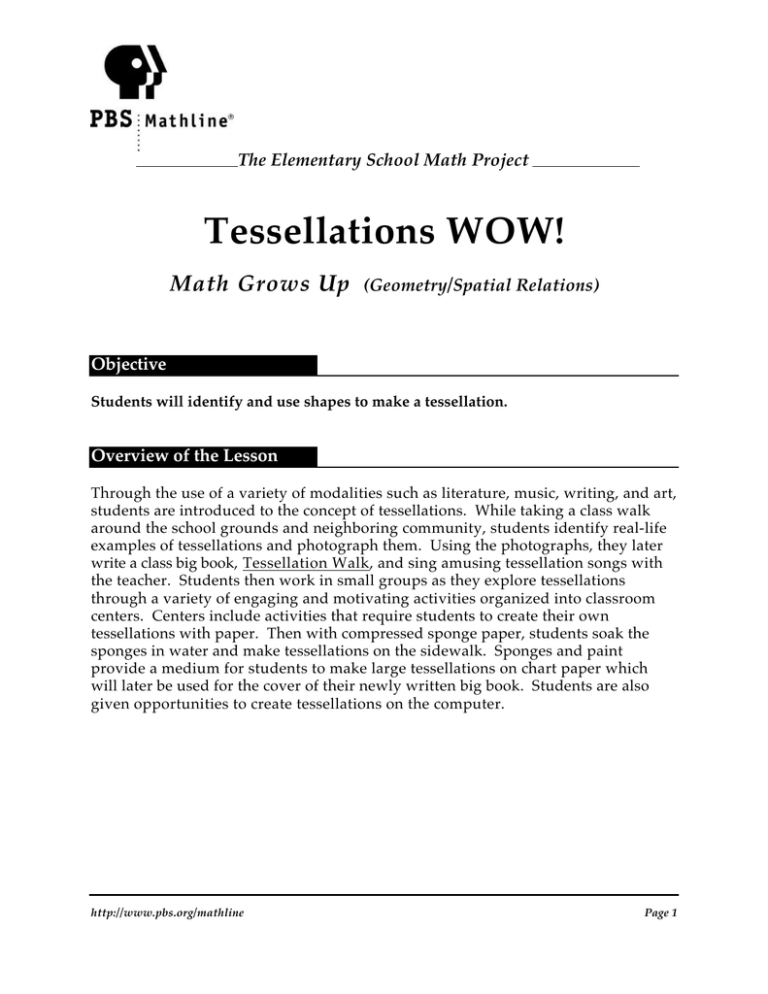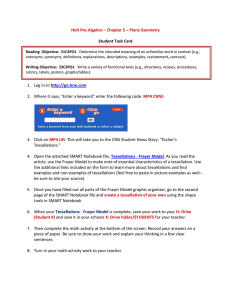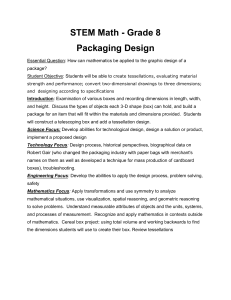Tessellations WOW!
advertisement

The Elementary School Math Project Tessellations WOW! Math Grows Up (Geometry/Spatial Relations) Objective Students will identify and use shapes to make a tessellation. Overview of the Lesson Through the use of a variety of modalities such as literature, music, writing, and art, students are introduced to the concept of tessellations. While taking a class walk around the school grounds and neighboring community, students identify real-life examples of tessellations and photograph them. Using the photographs, they later write a class big book, Tessellation Walk , and sing amusing tessellation songs with the teacher. Students then work in small groups as they explore tessellations through a variety of engaging and motivating activities organized into classroom centers. Centers include activities that require students to create their own tessellations with paper. Then with compressed sponge paper, students soak the sponges in water and make tessellations on the sidewalk. Sponges and paint provide a medium for students to make large tessellations on chart paper which will later be used for the cover of their newly written big book. Students are also given opportunities to create tessellations on the computer. http://www.pbs.org/mathline Page 1 PBS MATHLINE® Materials Teacher: • Camera and film • Tessellation and Tessellation WOW! song sheets Each Center: Center 1: • 3-4 pairs of scissors • Cardboard or poster board (4’ x 6” piece for each student) • White unlined paper (one piece for each student) • 4 boxes of crayons • 4 black markers Center 2: • TesselMania! computer program • Computers Center 3: • Boxes of a variety of snack crackers of various shapes • Bowls for crackers • Unlined paper (one piece per student) • Activity Sheet: “Which Crackers Will Tessellate?” Center 4: • Tempera paints (several colors) • Sponges (in shapes that will tessellate) • Large sheets of bulletin board paper Center 5: • Compressed sponge paper shapes (one per student) • Bucket of water • 4 permanent markers ESMP — Tessellations WOW! Lesson Guide • http://www.pbs.org/mathline Page 2 PBS MATHLINE® Center 6: • Lined paper (for each student) Procedure Take the class for a walk around the school grounds and neighboring community if possible. Have them notice examples of tessellations. Ask the students to explain why it is an example of a tessellation. Photograph examples as the students identify them. As a class, create a big book about tessellations, using the photographs taken on the walk as illustrations. Read the book with the class. Have the students review all of the things that they know about tessellations. You may wish to teach the students the songs, Tessellation and Tessellation WOW!, and have them sing with you. Divide the class into groups of four. Introduce the tessellation centers and have groups take turns exploring each center. A brief description of each center is listed below. Centers: Center 1 Instruct students to use scissors and poster paper or cardboard to make a tessellation piece. Have the students use the piece to tessellate it onto a piece of white unlined paper. Tell the students to use a black marker to outline each piece. Have the students color the tessellations. Encourage the students to discuss with their table group what they think their tessellating piece resembles. In Center 6 students will have the opportunity to write stories about their tessellations. Center 2 Have students use the software TesselMania! to create tessellations and to identify tessellation patterns. (Example of student generated sheet using software is included.) Center 3 Place bowls of a variety of snack crackers on the table. Encourage students to determine which crackers will tessellate. Give each student a piece of unlined paper to serve as a work mat for this activity. Have the students record their findings on the Activity Sheet: "Which Crackers Will Tessellate?" On the back of the Activity Sheet, have the students write a letter to their parents detailing what they have learned about tessellations from this activity. ESMP — Tessellations WOW! Lesson Guide • http://www.pbs.org/mathline Page 3 PBS MATHLINE® Center 4 Supply students with several pans of tempera paint and sponge shapes that will tessellate. Have the students tessellate the sponge shapes and make color patterns onto large chart paper or bulletin board paper. This can be used to make a cover for the class big book. (It may be a good idea to enlist parent volunteers to help with this activity.) Center 5 Cut a shape that will tessellate out of compressed sponge paper for each student. Allow each child to take the shape and decorate it with colorful permanent markers. Have the students predict what will happen to the shape when it is placed in a bucket of water. Have the students test their predictions by placing the shapes in water. This activity works very well outside of the school building. After the sponges have expanded, wring the water from the sponges and have the students assemble the sponges to make a tessellation. Students can then make tessellations on the sidewalk using their sponges and water. Center 6 Have students write about what they have learned from their explorations with tessellations. They may also write stories about their tessellations. Mathematically Speaking. . . Tessellation activities provide students with opportunities to recognize and manipulate polygons to create patterns and designs that will completely cover a plane leaving no spaces, gaps or overlaps. Triangles, quadrilaterals, and hexagons will always tessellate. However, not all regular polygons tessellate. Some polygons can be combined to form a tessellation. Investigating with these types of activities increases the students’ senses of spatial relationships. Extensions & Connections Have students use their computer generated tessellations to make book covers for stories they may write in writer's workshop. Invite artists or fabric designers to talk to students about ways they use tessellation in designing fabric patterns. ESMP — Tessellations WOW! Lesson Guide • http://www.pbs.org/mathline Page 4 PBS MATHLINE® Resources Compressed sponge (available at craft stores, packaged in small 3 x 5 pieces) Clear blocks for printmaking, Dale Seymour Publications TesselMania!® DELUX: The Art, Design, and Gift Making Tool. CD-ROM for Macintosh and Windows MECC•6160 Summit Drive North•Minneapolis, MN 55430-4003 Tele: 612/569-1500•http://www.mecc.com/ Geometry and Spatial Sense, Addenda Series National Council of Teachers of Mathematics, 1993 ESMP — Tessellations WOW! Lesson Guide • http://www.pbs.org/mathline Page 5 PBS MATHLINE® Ideas for Online Discussion (Some ideas may apply to more than one standard of the NCTM Professional Standards for Teaching Mathematics.) Standard 1: Worthwhile Mathematical Tasks • The concept of tessellations is a large mathematical idea that is normally not considered a “first grade” topic. What are your thoughts on introducing mathematical topics that may be considered advanced for the level you are teaching? Standard 2: Teacher’s Role in Discourse • How do you encourage students to talk, write, and work together, and at the same time, remain on task? Consider students who are reluctant to speak mathematically as you address this issue. How do you get the shy and reluctant students to be actively involved in group activities? Standard 4: Tools for Enhancing Discourse • Discuss the variety of concrete materials, computer activities, and other tools utilized in this lesson. What tools do you use to enhance students experiences in learning mathematics? Standard 5: Learning Environment • The teacher used the classroom, the hallways, and the outside as part of the learning environment. How have you used space in and around your school to “fit” the learning activity you designed? What obstacles or limitations have you faced and how have you overcome them? ESMP — Tessellations WOW! Lesson Guide • http://www.pbs.org/mathline Page 6 TESSELLATION Tessellation Has no gaps and it has no end. Tessellation! It is a fun word to say... Tessellation! Math and art come together and play. Tessellation! What I see is up to me! Tessellation! Help me think of things it can be. Tessellation! PBS MATHLINE® ESMP: Tessellations WOW! PBS MATHLINE® ESMP: Tessellations WOW! PBS MATHLINE® ESMP: Tessellations WOW! TESSELLATION WOW! CHORUS : 1. 2. 3. 4. 5. 6. 7. 8. Tesse Tessellations Wow! Tesse Tessellations Wow! First you take a square, a 3 inch square. Then you take a crayon and you color, color. Then you make a cut with scissors, scissors. The cut has to be in the corner, corner. Then you move the nibble to the bottom, the bottom. Now you’re ready to tessellate, tessellate. Tess el late means to tile, tile. Tile means to leave no spaces, no spaces. Now we all clap hands as we look at the square. Stop! Take a nibble from here to there. Now slide that nibble down where? Now slide that nibble to the bottom down there! Now look at your piece and what do you see? Rotate it ‘round. Oh, what can it be? Take your time and wink! Ask your neighbor... “What do you think?” Now trace that shape onto paper. Trace it again but beware! There should be no gaps or spaces. As you trace...check all your places! What you have now is a tessellation. This is your own math art creation. It is as unique as you. Isn’t it amazing what math can do. PBS MATHLINE® ESMP: Tessellations WOW!




